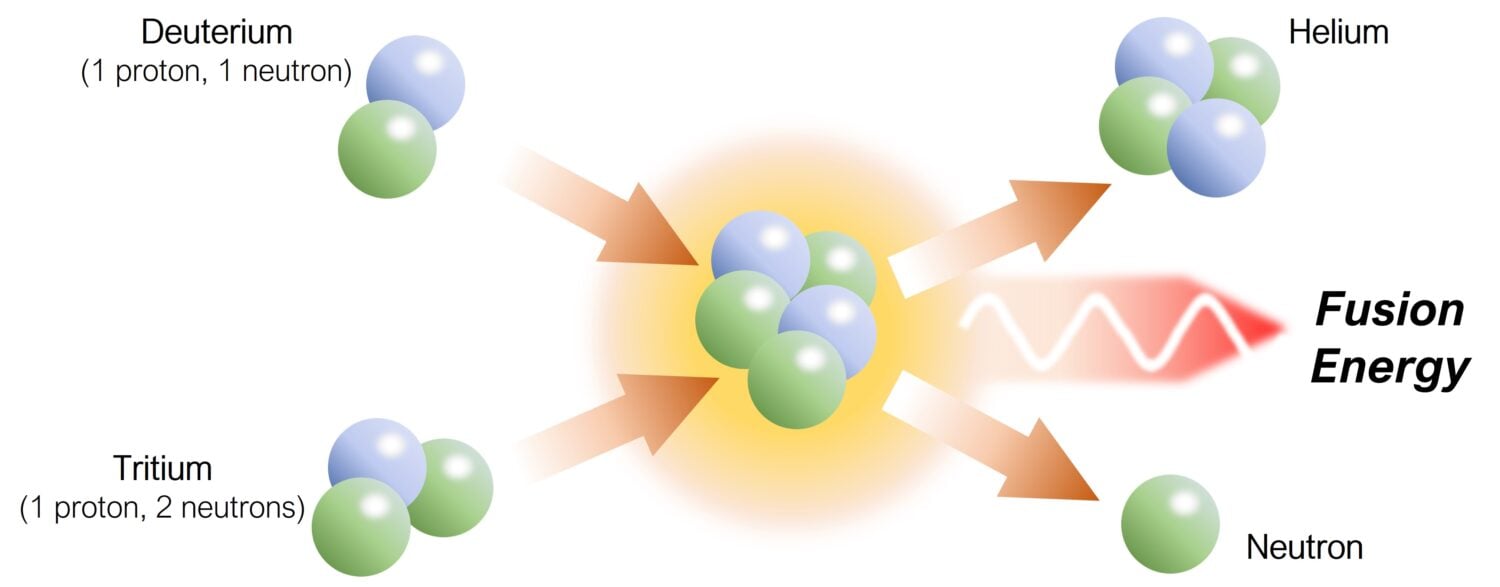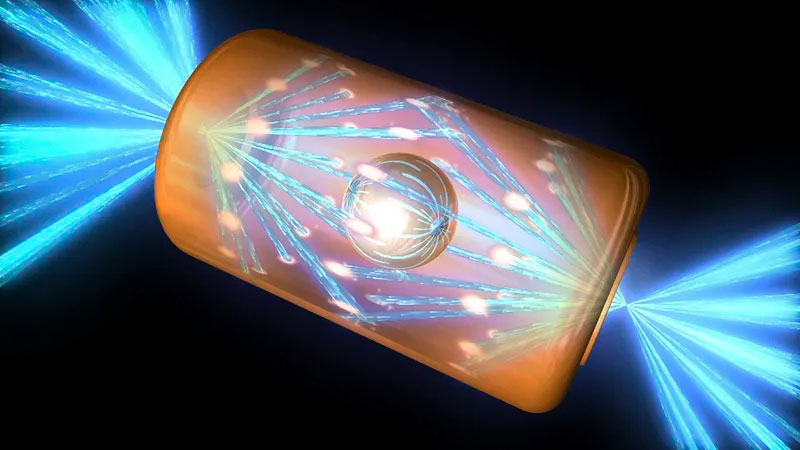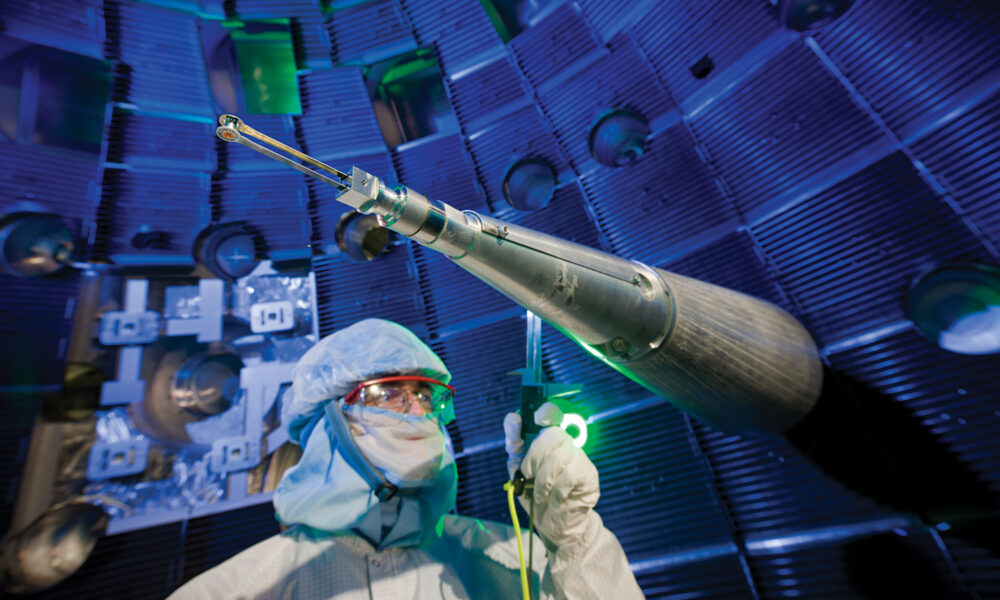On December 5, 2022, scientists at Lawrence Livermore National Laboratory in California focused the power of a stadium-sized laser at a target no larger than a thimble, vaporizing it within a few billionths of a second. Measurements soon showed that more energy came out of the target than went in – the first time that energy gain had ever been achieved in a laboratory fusion reaction. What does this experimental achievement mean for energy production? And what does this mean for nuclear weapons?
Physicists have dreamt of harnessing fusion power since 1920 when Arthur Eddington first proposed that the sun’s power may be coming from nuclear fusion— under the extreme pressures and temperatures within the sun, the natural repulsion between protons can be overcome, allowing hydrogen atoms to fuse into helium, releasing the energy that powers our star. In the years leading up to WWII, theoretical and experimental work by physicists and chemists indicated that tremendous amounts of energy could be unleashed, either by splitting heavy nuclei apart (fission) or by combining light nuclei together (fusion). Fission’s potential was demonstrated in the pre-dawn New Mexico desert when, on July 16, 1945, the Trinity device utilized the fission of plutonium to generate an explosion with a force equivalent to over 20,000 tons of TNT, shaking the world into the ‘Atomic Age’.

Dylan Spaulding/UCS
The still greater energy potential of nuclear fusion was demonstrated seven years later when a fission bomb was used to initiate fusion reactions in the world’s first demonstration of a thermonuclear device. The test, dubbed ‘Ivy Mike’, had a yield of 10.4 megatons – 450 times more powerful than the fission bomb detonated over Nagasaki. That astonishing increase in destructive power was made possible by the fact that fusion reactions, though harder to initiate, release far more energy than fission. Because of their greater power, thermonuclear weapons now dominate our nuclear arsenal.
Ever since, fusion has represented a powerful dichotomy as nature’s ultimate energy source and man’s most destructive capability. The pursuit of controlled fusion energy and the drive to build more sophisticated nuclear weapons have been linked ever since.
The role of the National Ignition Facility in the nuclear stockpile
The United States conducted more than 1,000 explosive nuclear tests from 1945-1992 in order to develop and test its nuclear weapons designs. In 1996, the US signed the Comprehensive Nuclear Test Ban Treaty (CTBT), agreeing to cease explosive nuclear tests. 185 other nations have since joined the treaty however the US remains one of 10 yet to ratify it, despite abiding by its terms. To understand the performance, longevity, and to maintain the existing nuclear weapons, the United States began a science-based “stockpile stewardship” program in which sophisticated laboratory experiments and advanced computer simulations are used to certify weapons viability and performance. The facility that carried out the ground-breaking Dec 5th experiment is key to this program. Known as the National Ignition Facility (NIF), it is the centerpiece of Lawrence Livermore National Laboratory and the successor of several prior laser facilities at the lab.
NIF has played an important role in the stockpile stewardship program by generating data on relevant materials that can be used to benchmark and improve computational models under temperature and density conditions that could previously only be reached with explosive nuclear tests. The size of three football fields, NIF can focus optical powers of up to ~500 trillion watts onto a mm-scale sample in a precise, highly tunable manner. It employs 192 laser beams that simultaneously fire a single pulse a few nanoseconds (billionths of a second) in duration.

US Department of Energy.
NIF’s lasers have been trained on materials across the periodic table to find out how they transform into liquids and plasmas at high density. This supports more detailed understanding of nuclear weapons physics, for example, of ‘boosted’ fission weapons (which also rely on fusion of deuterium and tritium) and of the processes occurring in the secondary phases of thermonuclear weapons where fusion reactions occur to increase yield. NIF can also be used to generate x-rays and gamma-rays which are used to study radiation hardness of weapons components and assemblies.
A bumpy road to fusion
The ability to drive matter to unprecedented densities and temperatures also makes NIF a unique tool for fusion research. Fusion requires overcoming the natural tendency for protons in the nuclei to push away other nuclei (like magnets set in opposition). NIF relies on a technique called ‘Inertial Confinement Fusion,’ or ICF, in which the laser light is converted to x-rays that ablatively drive off a thin diamond shell containing the fusion fuel. That process sends a powerful shock wave inward, heating and compressing the fuel to extraordinarily high pressures and temperatures (a hundred billion atmospheres and millions of degrees) – just enough, it turns out, to coax deuterium and tritium, both isotopes of hydrogen, to fuse into helium as Eddington originally postulated. This process is often compared to squeezing a water balloon without allowing it to bulge out of one’s fingers at any point.
A decade worth of frustratingly slow progress showed that even tiny imperfections or asymmetries during compression of the fuel can poison the outcome. This engineering challenge led many to reasonably doubt whether ICF was a viable approach to fusion at all. Throughout that time, progressive improvements were made in the laser infrastructure and in the production of targets with extremely tight tolerances. Models were tuned, the symmetry of compression was improved and, progressively, the hindrances that plagued previous attempts were better understood. In the Dec 5th experiment, 1.5 times as much energy was generated by fusion compared to the energy that reached the fuel. This was nearly double the previous record at NIF, achieved in August of 2021 but not repeated since.
Are we on the way to commercialized fusion energy?
Despite the recent, much-lauded result, NIF is not a nuclear fusion plant, nor will it ever be. The energy produced by the December 5th experiment only returned 1% of the total energy that came from the electrical grid to power the lasers. The lasers can be fired about once per day (and even less when the facility is pressed to its limits) whereas for ICF to be a viable energy source would require repetition at about 10 times per second and with a gain in energy much higher than 1.5. Competing technologies that rely on magnetic confinement using donut-shaped accelerators called ‘tokomaks’ may prove more feasible for commercialized fusion energy though they have yet to demonstrate a net gain of the type NIF produced. The largest such device, known as ‘ITER’ is a multi-national collaboration presently under construction in France while many smaller research tokomaks are operational worldwide.
While NIF’s result is an exciting science and engineering breakthrough built on decades of effort, it does not signal that commercial fusion for energy production is on the horizon. Many technical hurdles will need to be overcome first, and these will likely take decades; if a viable fusion power plant is like sending astronauts to the moon for the first time, this was, perhaps, Kitty Hawk. Thus, this result should not distract us from the fact that urgent action to develop clean energy sources and combat climate change is required in this decade.
A tool for science (and politics)
While most experiments are reserved for the purposes described above, NIF has also produced new results in fundamental science through a limited and competitive academic user program. Experiments have been carried out to study the internal structure of exoplanets, instabilities in supernovae, and nucleosynthesis in the earliest history of the universe. Because NIF can reach conditions inaccessible on any other platform, it permits new science in unexplored conditions, not just in weapons research.
At the same time, NIF is part of a new technological arms race. In the post-Cold War era, demonstration of technical competency in high-energy physics has become a surrogate method for nations to demonstrate the credibility of their nuclear deterrent. Other nuclear states, including the UK, France, Russia, and China either have or are developing large laser facilities, ostensibly for fusion research but also closely associated with nuclear modernization programs.
While the recent experimental breakthrough on NIF is likely to inspire private-sector interest, the reality of fusion’s dual-use nature means that ICF and defense research can never be fully disentangled. As with so many technological breakthroughs, the most powerful can also be the most destructive. As we learn to control the power locked in the atomic nucleus, it is up to us to choose how we use it.

